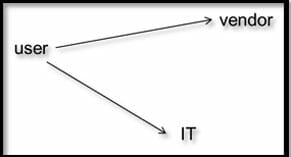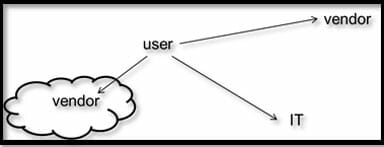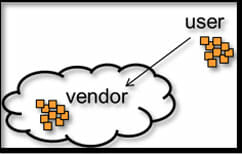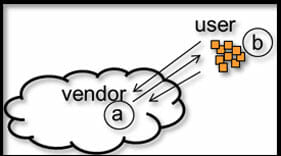Textual data is a valuable component for business analytics, but the responsibility for gathering and managing textual data is unclear.
Consider textual processing for delivering business value. Where does the end user turn?
The end user certainly recognizes the value of textual data. Intuitively the end user knows that there is a wealth of value to be found in text. But the end user also knows that unlocking that value is a complex task, sort of like learning how to do open heart surgery. So where does the end user turn to find help in unlocking the value in text? What is the solution when an organization does not have a formal enterprise data management program that can support textual data analysis?
Traditionally the end user has turned either to the Information Technology (IT) department or to the vendor community for help, as seen in Figure 1
Figure 1 – Traditional User Connections in IT
But there is a problem here. The first problem is that the IT department:
- Has no expertise in handling text
- Is very busy with existing tasks that have already been scheduled
And, when the IT user turns to the vendor, the IT department finds that the vendor is only interested in supporting existing products that don’t include text. Also, the vendor wants to sell them a massively expensive consulting project that has the industry reputation of not delivering any real results.
Additionally, the vendor thinks that text is Big Data and wants to sell the IT user a Big Data project (Note: there is a big difference between Big Data and text.)
So the IT user is stymied. The IT user recognizes that there is an opportunity in analyzing text, but neither the vendor nor the IT department are any help in trying to take advantage of the opportunity.
What is the frustrated IT user to do?
The frustrated IT user finds a different class of vendor in a different environment. Figure 2 shows this class of vendor
Figure 2 – Non-traditional Vendor and User Connections
The textual vendor is a vendor with few if any ties to classical vendors. The textual vendor is one who has a whole different approach to solving the user’s problems. The textual vendor is one who:
- Understands text
- Understands how to transform text into visualized data
- Has a unique approach to solving the end users problems
- Wants to provide the end user with results and accurate data, not technology
Typically, the textual vendor operates in the cloud and/or on the Internet. The textual vendor does not operate in the tightly confined boundaries of traditional IT, which is hosted owned, controlled, operated and managed by the same organization. The textual vendor is equipped to do ALL the processing necessary to solve the end user problems. The textual vendor is selling solutions, not technology, to solve the riddle of textual analytics.
Sometimes the data the textual vendor operates on, is in the environment, that the textual vendor operates in. On those occasions the data is already in the Internet or on the cloud and is immediately accessible to the textual vendor. On other occasions the data the textual vendor needs is in the end user’s environment. Figure 3 shows these two possibilities –
Figure 3 – Textual Data in Different Environments (User vs. Vendor)
Sometimes the textual vendor merely has to go scrape the data from the Internet. It is open, public data and is waiting there for the taking.
On other occasions the data resides in the end users’ environment. On those occasions the textual vendor’s access to the data is a bit more problematic.
One choice the textual vendor has is to port/move the vendor’s technology to the end users site and do the processing on the end users site. A second alternative is to transport the data to the vendor’s platform by means of a secure line and to process the data on the vendor’s platform.
Figure 4 shows these alternatives:
Figure 4 – Textual Data Transportation in Different Environments (User vs. Vendor)
In any case, the vendor processes the text and presents the end user with the results. The end user never has to go through a learning curve, does not have to worry about the acquisition and installation of new technology, and need not be concerned with all of the traditional practices associated with the acquisition and operation of new technology.
All the end user has to do is to start to analyze the newly found world of analytical data derived from text.







